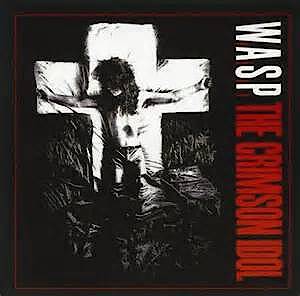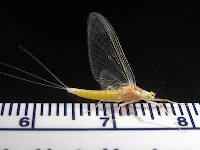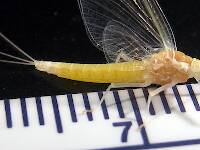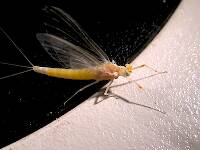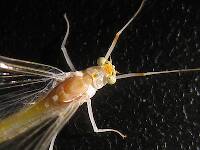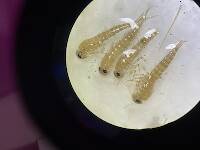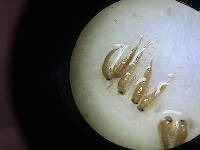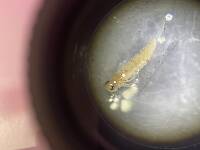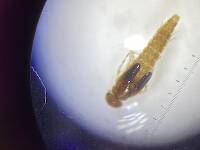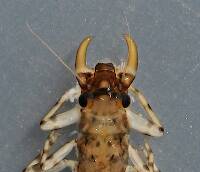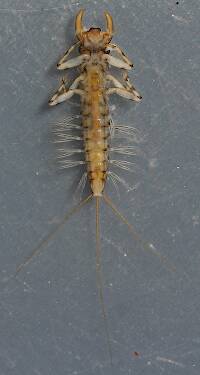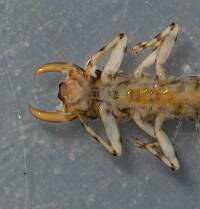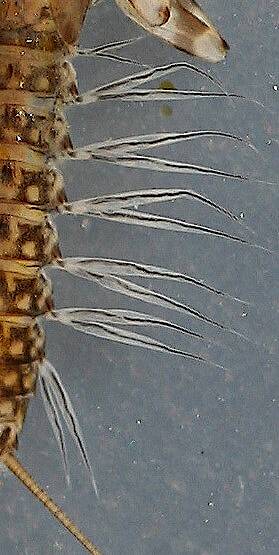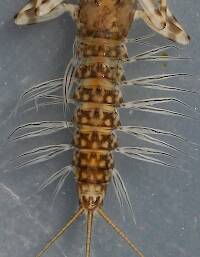
Salmonflies
Pteronarcys californica
The giant Salmonflies of the Western mountains are legendary for their proclivity to elicit consistent dry-fly action and ferocious strikes.
Featured on the forum

Troutnut is a project started in 2003 by salmonid ecologist Jason "Troutnut" Neuswanger to help anglers and
fly tyers unabashedly embrace the entomological side of the sport. Learn more about Troutnut or
support the project for an enhanced experience here.
Adirman on Apr 21, 2013April 21st, 2013, 7:23 am EDT
Guys;
I was wondering where I could get some relatively cheap collection jars for collection of mayflies,caddisflies, etc. for my students to study this fall. I am a high-school science teacher and teach a Conservation/Wildlife class focused exclusively on the study of my beloved trout! Also, if anyone could suggest chemicals for preservation of specimens would be great also.
Thanks so much for any input/edvice,
Adirman
I was wondering where I could get some relatively cheap collection jars for collection of mayflies,caddisflies, etc. for my students to study this fall. I am a high-school science teacher and teach a Conservation/Wildlife class focused exclusively on the study of my beloved trout! Also, if anyone could suggest chemicals for preservation of specimens would be great also.
Thanks so much for any input/edvice,
Adirman
Crepuscular on Apr 21, 2013April 21st, 2013, 9:22 am EDT
Glass or plastic?
Try bioquip or US plastics.
Ethanol for preservation
Try bioquip or US plastics.
Ethanol for preservation
Entoman on Apr 21, 2013April 21st, 2013, 10:04 am EDT
Ditto Eric's comments.
A cheaper alternative is to simply use old clear film canisters and rubbing alcohol. Most families have these around. The bugs will fade quicker and become more brittle, but this should work fine for the duration of your course.
Another alternative (as biological grade ethanol is neither cheap nor easy to get) is simple Gin or Vodka. For short term use it preserves the colors better and the critters remain more pliable for inspection. The low alcohol content will allow the breakdown of tissue, but if you change out the liquid a couple of times (day 2 and the following week) and keep them refrigerated, you'll had good short term success (to avoid household "gross outs", mine are in a beer refer in the garage). Great secret ingredient for a Dirty Martini too!:)
For longer term storage, nothing beats the small dram glass vials with stopper lids (avoid screw tops) and pure ethanol of at least 70% strength. Some like to pin their specimens but aquatics are too succulent for this IMO.
A cheaper alternative is to simply use old clear film canisters and rubbing alcohol. Most families have these around. The bugs will fade quicker and become more brittle, but this should work fine for the duration of your course.
Another alternative (as biological grade ethanol is neither cheap nor easy to get) is simple Gin or Vodka. For short term use it preserves the colors better and the critters remain more pliable for inspection. The low alcohol content will allow the breakdown of tissue, but if you change out the liquid a couple of times (day 2 and the following week) and keep them refrigerated, you'll had good short term success (to avoid household "gross outs", mine are in a beer refer in the garage). Great secret ingredient for a Dirty Martini too!:)
For longer term storage, nothing beats the small dram glass vials with stopper lids (avoid screw tops) and pure ethanol of at least 70% strength. Some like to pin their specimens but aquatics are too succulent for this IMO.
"It's not that I find fishing so important, it's just that I find all other endeavors of Man equally unimportant... And not nearly as much fun!" Robert Traver, Anatomy of a Fisherman
Creno on Apr 21, 2013April 21st, 2013, 2:46 pm EDT
Not sure what is meant by screw tops vs stoppers but I believe the polyseal screw tops will prove to exceed the life of all but the most expensive stoppers like West stoppers. It needs to be recognized that all longterm collections (more than a couple months)need maintenance. I check my collection every year for evaporation, broken vials, etc. I have had screwtop polyseal cones now for 40 years and they are doing fine. When they fail they will do it in the first year or so and it is usually due to a mis-shaped vial rim or a bent polyseal.
The various push/snap cap plastic stoppers don't stop evaporation very long but are probably the least expensive approach and may be the best choice for the short term purpose needed as well as long term storage. If you burp the push cap by squeezing out a little air while sealing it creates a vacuum just like the necessary burping of a neoprene stopper and they will seal much longer. If you want long term storage for these vials just replace the snap cap with a wad of cotton and place numerous vials (all of one species, family, location, etc.) in mason jars of the appropriate size, flood with preservative, and seal. Every year or so look at the mason jar to see if it is still full and top them off or replace a seal now and then and they will be fine. The bulk storage like this saves you the need to look at every vial one at a time - if the jar is full the vial is full. Most major collections use variations of this method for long term storage. Many use only use some type of shell vials in large jars for all their fluid collections. You can get straight side jars for this purpose.
If we are mentioning sources we should include Acme Vial. While their web site, like Bioquip is a little crude, give them a call, they are very friendly and they usually have what you want, when you want. And if you are buying bulk (a gross or more)a price you want. If anyone knows of other sources please let me know, I am always looking for sources to feed my vial habit.
The various push/snap cap plastic stoppers don't stop evaporation very long but are probably the least expensive approach and may be the best choice for the short term purpose needed as well as long term storage. If you burp the push cap by squeezing out a little air while sealing it creates a vacuum just like the necessary burping of a neoprene stopper and they will seal much longer. If you want long term storage for these vials just replace the snap cap with a wad of cotton and place numerous vials (all of one species, family, location, etc.) in mason jars of the appropriate size, flood with preservative, and seal. Every year or so look at the mason jar to see if it is still full and top them off or replace a seal now and then and they will be fine. The bulk storage like this saves you the need to look at every vial one at a time - if the jar is full the vial is full. Most major collections use variations of this method for long term storage. Many use only use some type of shell vials in large jars for all their fluid collections. You can get straight side jars for this purpose.
If we are mentioning sources we should include Acme Vial. While their web site, like Bioquip is a little crude, give them a call, they are very friendly and they usually have what you want, when you want. And if you are buying bulk (a gross or more)a price you want. If anyone knows of other sources please let me know, I am always looking for sources to feed my vial habit.
Crepuscular on Apr 21, 2013April 21st, 2013, 3:16 pm EDT
I agree with Dave the poly seal screw caps are the best. I have samples that are over a decade old and have not lost any ethanol using the poly seal
caps. Adirman, I sent you a PM.
caps. Adirman, I sent you a PM.
Entoman on Apr 21, 2013April 21st, 2013, 4:00 pm EDT
The screw caps I was referring to are the hard plastic ones with the glossed tyvek paper seals shoved into them? They can leak and you can't get the bubble out as easily, which can be as damaging as a small pebble. The glass isn't straight and the neck is a little narrower too. This makes extraction a little more difficult as the little buggers often hang up in the shoulder. My recommendations fall far short of the requirements of a curated collection but may be a better fit for a high school class with limited funds. I'm assuming the kids are going to collect and study for a semester and then throw them out. Are you planning on keeping them in perpetuity for future classes, Adir? That makes a big difference.
"It's not that I find fishing so important, it's just that I find all other endeavors of Man equally unimportant... And not nearly as much fun!" Robert Traver, Anatomy of a Fisherman
Crepuscular on Apr 21, 2013April 21st, 2013, 4:17 pm EDT
Yeah Kurt those caps you are describing are terrible. And I may be able to help Adirman out depending upon what sizes and quantities he is looking for. :)
Entoman on Apr 21, 2013April 21st, 2013, 4:29 pm EDT
I'm glad you are able to help, Eric. I wished my HS bio teachers were like Adir! BTW Adir - If you do spend the dough for the right stuff to keep your collection in perpetuity, you might still want to do the other for the kids to work with. I wouldn't advise letting them handle your collection preserved with the professional methods and materials. After all that time and money, dollar against a doughnut you'll end up with a mangled blend of body parts after a few semesters!:)
"It's not that I find fishing so important, it's just that I find all other endeavors of Man equally unimportant... And not nearly as much fun!" Robert Traver, Anatomy of a Fisherman
Martinlf on Apr 21, 2013April 21st, 2013, 5:33 pm EDT
If you use gin or vodka, just keep an eye on those high school students. Your collection could go missing fast if they find out what's in the jars.
"He spread them a yard and a half. 'And every one that got away is this big.'"
--Fred Chappell
--Fred Chappell
Entoman on Apr 21, 2013April 21st, 2013, 5:45 pm EDT
HA!HA! Bugs or not, I suppose!:) That recommendation was a little tongue in cheek, though the slick kids will figure out the same thing with pure ethanol as well. I'd just use over-the-counter rubbing alcohol (ethanol not Isopropyl) if it's only for the semester and they aren't going to be kept. It's cheap, kids won't pilfer it for entertainment, and it will get the job done for the limited purpose.
"It's not that I find fishing so important, it's just that I find all other endeavors of Man equally unimportant... And not nearly as much fun!" Robert Traver, Anatomy of a Fisherman
Entoman on Apr 21, 2013April 21st, 2013, 9:11 pm EDT
BTW - thought it would be interesting to continue this thread by discussing what we we prefer and why. Comparing notes should be interesting and informative.
For most of my experience over quite a few years, my collecting was only out of a desire to study what the fish were eating and to design flies that worked. Besides helping to learn what their (trout) food looked like, how it behaved, and be able to identify it in the field, the specimens also came out frequently when tying (that's the best advice I can give to those tiers working on getting their proportions right). Because of this frequent access I've always liked the shell vials. I found them the easiest for handling the specimens as little as possible - they pour cleaner without that shoulder to snag on and the bigger hole is a little easier to stuff'em back in. Though I had bad experiences with the cheap screw caps, I haven't had any issues with the shell stoppers and they are much easier to bleed out damaging air bubbles. I really didn't care much what they were made of, though the cheapest I could find were usually glass so that's what I usually bought. I think I paid about $15 or so by the gross (144 ct) for the last of that type I bought?
Getting into photographing trout bugs a few years ago really changed my perspective. What a marvelous tool macro-photography is! You can look up close at the critters without having to take out the microscope every time. Flies, too. To compare textures and color patterns with the naturals is an amazing advantage over what the Masters had to work with. That, and a website like this to share info and opinions and work on solutions is a real boon and a quantum leap from the isolation we operated in previously. But I digress.... Anyway, the problem is I'm still photo challenged and don't mess with the camera much in the field. It's tough enough for me to break off from fishing to collect critters as it is.:) Also, I live hours from my favorite trout fishing so can't/don't usually want to mess with transferring live nymph specimens back home. This means I mostly work with the dead ones for detailed photos.
One of the many tips I've picked up from Taxon is shooting them while still in the vial. Not only are the critters handled less, but you can often get them orientated to the camera in ways you just can't do easily in a dish. This requires the more expensive borosilicate glass, which is important for taking photos and looking through. You just can't do it with cheap glass or plastic. I use the one dram for most and the two drammers for the big critters. My last ones were from Kimble Chase. The price for a gross (144 pc.) including case and stoppers was under $60, if I remember. I don't know if that's a good deal or not but since I don't go through them by the gross like an entomology worker would, it's not that big a factor.
As for short term preservation, I do prefer vodka or gin with the critters stored in a refer (I often joke that the botanicals in Bombay Sapphire are particularly effective). The reason is because very little discernible color change takes place in most species for quite awhile (notable exceptions are caddis larvae) and the specimens stay relatively limber. This is important if you want to manipulate appendages for proportion checking. I only use the 70% Ethanol for permanent storage, when I'm pretty sure I'm done with them. The problems I've noticed with the hi-octane stuff if used right off the bat is you get increased brittleness, excessive bleaching, and often tissue distortion and/or exudation. Fine for specimens that will be cleared and dissected or for curated collections, but not for my photo or fly tying purposes. The closest they look to when alive, the better. My specimens are working specimens. Until they are put in the potent stuff they are always on call for measurements, manipulation, and modeling.:)
For most of my experience over quite a few years, my collecting was only out of a desire to study what the fish were eating and to design flies that worked. Besides helping to learn what their (trout) food looked like, how it behaved, and be able to identify it in the field, the specimens also came out frequently when tying (that's the best advice I can give to those tiers working on getting their proportions right). Because of this frequent access I've always liked the shell vials. I found them the easiest for handling the specimens as little as possible - they pour cleaner without that shoulder to snag on and the bigger hole is a little easier to stuff'em back in. Though I had bad experiences with the cheap screw caps, I haven't had any issues with the shell stoppers and they are much easier to bleed out damaging air bubbles. I really didn't care much what they were made of, though the cheapest I could find were usually glass so that's what I usually bought. I think I paid about $15 or so by the gross (144 ct) for the last of that type I bought?
Getting into photographing trout bugs a few years ago really changed my perspective. What a marvelous tool macro-photography is! You can look up close at the critters without having to take out the microscope every time. Flies, too. To compare textures and color patterns with the naturals is an amazing advantage over what the Masters had to work with. That, and a website like this to share info and opinions and work on solutions is a real boon and a quantum leap from the isolation we operated in previously. But I digress.... Anyway, the problem is I'm still photo challenged and don't mess with the camera much in the field. It's tough enough for me to break off from fishing to collect critters as it is.:) Also, I live hours from my favorite trout fishing so can't/don't usually want to mess with transferring live nymph specimens back home. This means I mostly work with the dead ones for detailed photos.
One of the many tips I've picked up from Taxon is shooting them while still in the vial. Not only are the critters handled less, but you can often get them orientated to the camera in ways you just can't do easily in a dish. This requires the more expensive borosilicate glass, which is important for taking photos and looking through. You just can't do it with cheap glass or plastic. I use the one dram for most and the two drammers for the big critters. My last ones were from Kimble Chase. The price for a gross (144 pc.) including case and stoppers was under $60, if I remember. I don't know if that's a good deal or not but since I don't go through them by the gross like an entomology worker would, it's not that big a factor.
As for short term preservation, I do prefer vodka or gin with the critters stored in a refer (I often joke that the botanicals in Bombay Sapphire are particularly effective). The reason is because very little discernible color change takes place in most species for quite awhile (notable exceptions are caddis larvae) and the specimens stay relatively limber. This is important if you want to manipulate appendages for proportion checking. I only use the 70% Ethanol for permanent storage, when I'm pretty sure I'm done with them. The problems I've noticed with the hi-octane stuff if used right off the bat is you get increased brittleness, excessive bleaching, and often tissue distortion and/or exudation. Fine for specimens that will be cleared and dissected or for curated collections, but not for my photo or fly tying purposes. The closest they look to when alive, the better. My specimens are working specimens. Until they are put in the potent stuff they are always on call for measurements, manipulation, and modeling.:)
"It's not that I find fishing so important, it's just that I find all other endeavors of Man equally unimportant... And not nearly as much fun!" Robert Traver, Anatomy of a Fisherman
Adirman on Apr 22, 2013April 22nd, 2013, 2:18 pm EDT
Entoman;
Sorry, whats that with the mangled preserved specimens thing again? You mean the preservative starts to chew them up a bit?
Thanks,
Adirman
Sorry, whats that with the mangled preserved specimens thing again? You mean the preservative starts to chew them up a bit?
Thanks,
Adirman
Adirman on Apr 22, 2013April 22nd, 2013, 2:21 pm EDT
As another aspect to this thread, any of you bug guys have suggestions for best collection methods? I can see myself going out to the stream and mangling my collections by not doing it right! Seems like I always squash a few in my fingers and in particular, there always seems to be extensive damage to the wing structures and/or the legs.
Entoman on Apr 22, 2013April 22nd, 2013, 3:21 pm EDT
I think I misunderstood you, Adir. I assumed you were going to have the kids do their own collecting and preservation for study. Collecting for yourself is a different proposition and the advice you received from Dave and Eric is the way to go. Almost every entomology text book I'm aware of has chapters on good collection, preservation, and data recording methods. Google search or head to the library. Dave's advice on making sure date and location info is with the specimen (either on or in the vial) is very important. A bug in a bottle without this info is useless after memory fades.
No, the kids will from handling them.:) If this is going to be your personal collection, I wouldn't let the kids touch them outside of the vials. If the purpose is to let them observe them in the vials, I'd go with affordable glass shell vials (under $15 per 144 ct) with the plastic stoppers and use 70% ethanol. Keep out air bubbles and your kids can handle the vials to their hearts content. Plastic vials are a good option as they aren't breakable, but the trade-off is the viewing isn't as good. For my personal stuff, I've gone to the expensive glass as mentioned above because it is very clear and distortion free. That's important for me when photographing or modeling for fly design, but not a big issue for the classroom.
Collection methods? For nymphs in riffles, I prefer a kick net with no kicking (hard to do alone). Hold the net in the water at a slight angle downstream and have somebody a few feet upstream rub rocks with their hands gently. Then lift them a little off the bottom and do the same thing, working the sides and underneath the cobble. Not only is the sample usually greater but the poor critters (and the stream bed) will be less damaged. For nymphs in weedbeds and soft bottoms, I prefer a sturdy D-net. For adults, a butterfly net works pretty good. Manipulate the flies into a clear box. Try not to touch the wings. Porch lights or camp lights (with something flat next to it for the flies to land on) near the water are great collection tools.
Sorry, whats that with the mangled preserved specimens thing again? You mean the preservative starts to chew them up a bit?
No, the kids will from handling them.:) If this is going to be your personal collection, I wouldn't let the kids touch them outside of the vials. If the purpose is to let them observe them in the vials, I'd go with affordable glass shell vials (under $15 per 144 ct) with the plastic stoppers and use 70% ethanol. Keep out air bubbles and your kids can handle the vials to their hearts content. Plastic vials are a good option as they aren't breakable, but the trade-off is the viewing isn't as good. For my personal stuff, I've gone to the expensive glass as mentioned above because it is very clear and distortion free. That's important for me when photographing or modeling for fly design, but not a big issue for the classroom.
Collection methods? For nymphs in riffles, I prefer a kick net with no kicking (hard to do alone). Hold the net in the water at a slight angle downstream and have somebody a few feet upstream rub rocks with their hands gently. Then lift them a little off the bottom and do the same thing, working the sides and underneath the cobble. Not only is the sample usually greater but the poor critters (and the stream bed) will be less damaged. For nymphs in weedbeds and soft bottoms, I prefer a sturdy D-net. For adults, a butterfly net works pretty good. Manipulate the flies into a clear box. Try not to touch the wings. Porch lights or camp lights (with something flat next to it for the flies to land on) near the water are great collection tools.
"It's not that I find fishing so important, it's just that I find all other endeavors of Man equally unimportant... And not nearly as much fun!" Robert Traver, Anatomy of a Fisherman
Adirman on Apr 23, 2013April 23rd, 2013, 2:53 pm EDT
Excellent Entoman. Yes, the kids will not be collecting (at least not the way I envision it going down as of right now), and will simply be observing specimens. Based on your advice, I think the glass does sound preferable so that they can observe the specimens w/ more clarity.
So, better to go out collecting for the adults at dusk or near dark, also with a light?
Thanks so much,
Adirman
So, better to go out collecting for the adults at dusk or near dark, also with a light?
Thanks so much,
Adirman
Entoman on Apr 23, 2013April 23rd, 2013, 4:26 pm EDT
Yes. A a battery powered Coleman camp lantern works pretty good. Just set up a cardboard box next to it for the bugs to land on. You'll be surprised what you're able to collect in a couple of hours. Another thing that works is leaving a car door open with the interior lights on while getting ready to go. You will bring home a pretty good collection. Some you'll want, some you won't (even for the ride home).:)
"It's not that I find fishing so important, it's just that I find all other endeavors of Man equally unimportant... And not nearly as much fun!" Robert Traver, Anatomy of a Fisherman
Entoman on Apr 23, 2013April 23rd, 2013, 4:36 pm EDT
BTW - the ones that kids seem the most interested in are: Big cased caddis, big stonefly nymphs, dragonfly nymphs, and hellgrammites. Warm water ponds and riffles are the best bets for the latter two. Little mayflies and caddis adults don't deliver much bang for the buck in my experience... Unless they are budding fly fishers.:) You'll need at least 2 dram (4 would be better) for these.
"It's not that I find fishing so important, it's just that I find all other endeavors of Man equally unimportant... And not nearly as much fun!" Robert Traver, Anatomy of a Fisherman
Entoman on Apr 23, 2013April 23rd, 2013, 6:32 pm EDT
BTW2 - it's preferable to kick cobble around in front of the net in hellgrammite water. I wouldn't want to gently rub stones with my hands where they can be found...:)
"It's not that I find fishing so important, it's just that I find all other endeavors of Man equally unimportant... And not nearly as much fun!" Robert Traver, Anatomy of a Fisherman
Adirman on Apr 24, 2013April 24th, 2013, 4:38 pm EDT
Excellent, thank you sir! And, I could take pics and post to have help in id'ing by you bug guys right?
Most appreciative, your friend,
Adirman
P.S.
I wonder if this little collecting endeavor this summer will make me a better trout fisherman??
Most appreciative, your friend,
Adirman
P.S.
I wonder if this little collecting endeavor this summer will make me a better trout fisherman??
Entoman on Apr 24, 2013April 24th, 2013, 11:00 pm EDT
Of course!
"It's not that I find fishing so important, it's just that I find all other endeavors of Man equally unimportant... And not nearly as much fun!" Robert Traver, Anatomy of a Fisherman
Quick Reply
Related Discussions
Topic
Replies
Last Reply
9
Dec 5, 2020
by Creno
by Creno
5
Jul 24, 2008
by GONZO
by GONZO
5
Jun 22, 2012
by Falsifly
by Falsifly



